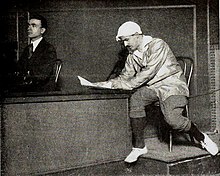Michel Fokine
Michael Fokine | |
|---|---|
| Михаил Фокин | |
choreographer | |
| Spouse | Vera Fokina |
Michael Fokine
Career
Early years



Fokine was born in
Transition to choreographer
He became frustrated with the life of a dancer and began considering other paths, including painting. In 1902, he was offered a teaching position at the Imperial Ballet School and was able to explore the artistic possibilities of choreography. In 1905, he created his first full-length ballet, Acis et Galatée, which was performed by his students and based on a Sicilian legend. Among his students were Desha Delteil and Bronislava Nijinska.
Some of Fokine's early works include the ballet Acis and Galatea (1905) and
Ballets Russes
In 1909,
He left Ballets Russes in 1912. In 1914, Diaghilev convinced Fokine to return to Ballets Russes, where he then created the ballets Midas, Josephslegende, and Le Coq d'Or.[3] The Paris premiere of The Golden Cockerel by Ballets Russes in 1914 was an opéra-ballet, guided by Fokine with set design by Natalia Goncharova.
American Ballet Company
The outbreak of the
His ballet Les Sylphides was the first production at the American Ballet Theatre on 11 January 1940. In 1937, Fokine joined Wassily de Basil's offshoot of the Ballets Russes, which was eventually named the Original Ballet Russe. Among the new works Fokine created during this period were Cendrillon (1938) and Paganini (1939). His choreography was featured with the company until 1941.
Fokine staged more than eighty ballets in
Death
Fokine died in New York on 22 August 1942, aged 62. In tribute to his death, seventeen ballet companies around the world performed Les Sylphides simultaneously.[citation needed]
Teaching methods and style
Fokine aspired to move beyond traditional ballet, toward a method of utilizing ballet to communicate the natural beauty of Man. He did not believe virtuoso ballet techniques to symbolize anything, and thought they could be substituted with forms that better expressed emotions and themes. Fokine was a strong believer in the communicative power of dance and pushed for creativity that broke tradition, believing that tradition is often distinct from reality and fails to capture the entire spectrum of human emotions. He believed that unless movements are expressive, they are irrational and neither delightful nor tolerable.[4]
Fokine also sought to strip ballets of their artificial technicality and outdated costumes. He believed that many of the ballets of his time used costumes and techniques that did not reflect the themes of the ballets. Fokine studied
He also experimented with shifting the emphasis of movement away from the lower body and towards the whole body, with freer use of the arms and torso and using each muscle with clear intention.[4] In doing so, Fokine sought to unify motion with emotion and the body with the soul, bringing new life to the ballet as a language and an art.
In 1923, he choreographed the ballet Ajanta Frescoes for Anna Pavlova after she had been inspired by her visit to the Ajanta Caves.[5]
Cultural depiction
- Nijinsky (film), film by Herbert Ross - portrayed by Jeremy Irons (1980)
- Anna Pavlova, film by Emil Loteanu - portrayed by Sergey Shakurov (1983)
Tribute To Ballet, with Prefatory poem To M. Michel Fokine, by John Masefield (1938)
See also
References
Notes
- ^ Fokine, Michel (author), Anatole Chujoy (editor). Fokine: Memoirs of a Ballet Master. Little, Brown and Company., 1961.
- ISBN 9780500203521.
- ISBN 0-297-77506-5, p. 268.
- ^ ISBN 0-87127-173-7.
- ^ Lakshmi Shreeram, "The Pavlova Project: A unique exhibition presents the life and work of legendary ballerina through her costumes", Firstpost, 21 January 2020.. https://www.firstpost.com/living/the-pavlova-project-a-unique-exhibition-presents-the-life-and-work-of-legendary-ballerina-through-her-costumes-7928291.html. Retrieved 21 March 2021.
References
- Beaumont, C. W., Michel Fokine and His Ballets, ISBN 1-85273-050-1
- Anderson, Jack. "DANCE VIEW; Fokine -- The Undervalued Revolutionary". The New York Times. 7 September 1980. p. 8.
- "Michel Fokine|Russian Dancer and Choreographer." Encyclopædia Britannica Online. Encyclopædia Britannica. Web. 21 February 2016.
